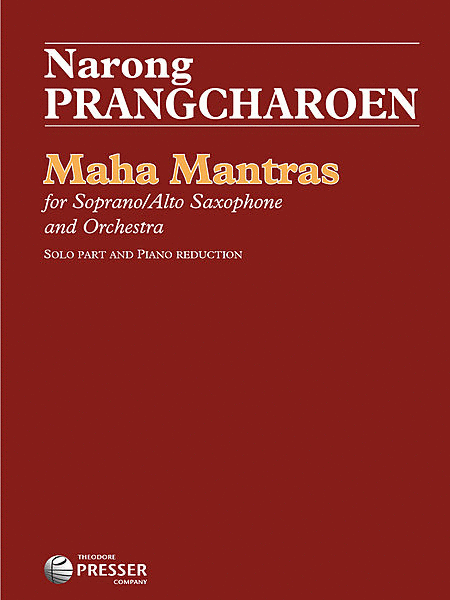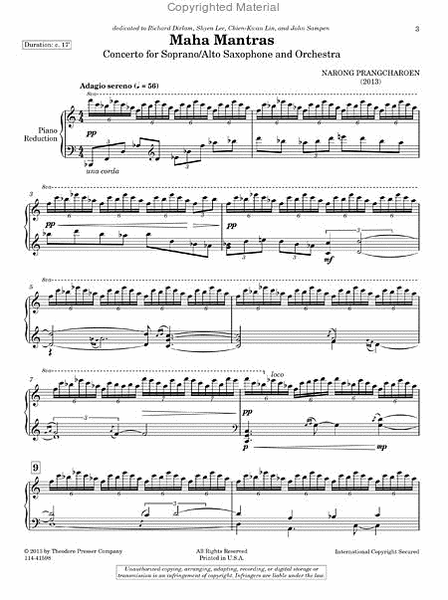Maha Mantras
Concerto for Alto/Soprano Saxophone and Orchestra
-
Ships in 1 to 2 weeks
Details
Description
SKU: PR.114415980
Concerto for Alto/Soprano Saxophone and Orchestra. Composed by Narong Prangcharoen. This edition: Solo Part/Piano Reduction. Sws each. Contemporary. Set of Score and Parts. With Standard notation. Composed 2013. 28+8 pages. Duration 17 minutes. Theodore Presser Company #114-41598. Published by Theodore Presser Company (PR.114415980).ISBN 9781598064964. UPC: 680160615803. 9x12 inches.
Maha Mantras for Soprano/Alto Saxophone and OrchestraCast in one movement with many “subplots,” Maha Mantras is a concerto for saxophonist switching between Soprano and Alto, featuring a dazzling tour-de-force cadenza in which the soloist plays both instruments simultaneously.A profound synthesis of Prangcharoen’s native Thai soundworld and Western symphonic tradition, Maha Mantras is based on pentatonic themes tinged with highly ornate and chromatic shadings. The work’s title indicates a magnification and development of the composer’s earlier work Mantras, both compositions inspired by the creation of music as a healing force. For advanced performers. Duration: 17'The music of NARONG PRANGCHAROEN has been called “absolutely captivating” (Chicago Sun Times). Still in his early years, Prangcharoen has established an international reputation and is recognized as one of the leading composers of his generation. He has received many international prizes including the Alexander Zemlinsky International Composition Competition Prize, the 18th ACL Yoshiro IRINO Memorial Composition Award, the Pacific Symphony’s American Composers Competition Prize, the Toru Takemitsu Composition Award, and the Annapolis Charter 300 International Composers Competition Prize. In 2007, the Thai government named him a Contemporary National Artist awarding him the Silapathorn Award, one of Thailand’s most prestigious honors.Prangcharoen’s music has been performed around the world by many renowned ensembles such as the Tokyo Philharmonic, Pacific Symphony, Grant Park Orchestra, Nagoya Philharmonic, Melbourne Symphony, Annapolis Symphony, and Bohuslav Martinu Philharmonic, under many celebrated conductors such as Carl St. Clair, Carlos Kalmer, Jose-Luis Novo, and Mikhail Pletnev. His music has also been presented by The Chamber Music Society of Lincoln Center, Ensemble TIMF, New York New Music Ensemble, Imani Winds, and pianist Bennett Lerner.In addition, his music has been performed at many important festivals, such as the Grant Park Music Festival (Millennium Park, Chicago), Asia: The 21st Century Orchestra Project (Nagoya, Japan), MoMA Music Festival (Museum of Modern Art, NYC), Maverick Concerts: “Music in the Wood” (the oldest continuous summer chamber music series in the USA), Carnegie Hall’s Weill Recital Hall, and the Library of Congress.Mr. Prangcharoen’s earliest composition studies were with Narongrit Dharmabutra in Thailand. He later studied with Stephen Taylor and David Feurzeig at Illinois State University. Prangcharoen went on to study at the University of Missouri in Kansas City, where his teachers included Chen Yi, Zhou Long, James Mobberley, and Paul Rudy.Narong Prangcharoen has taught in the Western Music Department of Srinakharinwirot University, Bangkok. He has served an Instructional Assistant Professor of Music in Composition at Illinois State University and taught at the Community Music and Dance Academy of the Conservatory of Music, University of Missouri in Kansas City. Prangcharoen founded the Thailand Composition Festival in Bangkok, now in its fifth year, and has been awarded a Music Alive composer residence with the Pacific Symphony for the 2013-2016 seasons. .
Program Notes by the ComposerMantras are mystic sounds which produce certain type of energy, depending on the sounds, vibrations, and rhythms of each mantra. The Sanskrit word “mantra” comes from “man” (“mind”) and “tra” (“to free”). A mantra is a sound or prayer that frees the mind from the miseries of the material world. Mantras are considered capable of “creating transformation,” both physically and mentally. It is believed that mantras are not just normal sounds, but also have the power to heal one’s suffering.The title Maha Mantras does not actually get its meaning from the Sanskrit words. “Maha” means “great” or “big,” and I translate the title as “The Greater Mantras.” This is because the work derives from another of my compositions, “Mantras” for soprano saxophone and wind ensemble, with the additional use of the alto saxophone. The piece is divided into two sections: the first, in slow tempo, presents meditative sounds; the second, in fast tempo,derives from the “Petition for Rain” ceremony performed in Isaan, the northeast region of Thailand. The main music material of the work is derived from only four notes (G, A, E, and D), with extensive thematic transformation. The use of saxophone is mainly focussed on the combination of its timbre with that of the other instruments, in an attempt to create a transcendental, vibrating sound for the ensemble.Music and sounds are not just a medium in which an artist can express himself, but have practical and powerful applications in the real world. The idea of using mantras for healing is really the main inspiration for this piece. If mantras can heal human beings, one can hope to have at least one mantra that will help to heal the earth.I would like to thank Richard Dirlam, Shyen Lee, Chien-Kwan Lin, Jean-Marie Londeix, and John Sampen for their support in creating this work. It was a great pleasure to be able to work on this piece with so many great saxophonists.* * *Les mantras sont des formules mystiques de sons, qui produisent certains types d’énergie, selon les bruits, les vibrations et lesrythmes utilisés. Le mot sanscrit «mantra» vient de «man» (esprit) et «tra» (libérer). Un mantra est une combinaison sonore, ou une prière, qui libère de la misère du monde matériel. Les mantras sont considérés comme capables de «transformation - création», à la fois physiquement et mentalement. On croit que les mantras ne sont pas des sons tout à fait normaux, mais qu’ils ont aussi le pouvoir de guérir la souffrance.Le titre «Maha Mantras» ne trouve pas son sens uniquement dans des mots sanscrits. «Maha» signifie «excellent» ou «grand», et jetraduis le titre par «Grand Mantras». Le morceau dérive en partie d’une autre de mes compositions, «Mantras» pour saxophonesoprano et ensemble à vent, à laquelle j’ai ajouté le saxophone alto. La pièce est divisée en deux sections: la première, de tempo lent,présente des sons méditatifs; la seconde, de tempo rapide, dérive de la «supplication à la pluie», cérémonie célébrée dans l’Isaan,région nord-est de la Thaïlande. Le matériau principal de l’ouvrage est dérivé de seulement quatre notes (sol, la, mi, ré), avecune vaste transformation thématique. L’utilisation du saxophone se concentre principalement sur la combinaison de son timbreà celui des autres instruments, en cherchant à créer un son transcendantal et vibrant pour l’ensemble.Musique et sons ne sont pas seulement un milieu dans lequel l’artiste peut s’exprimer. Il peut aussi avoir des applications pratiques et puissantes dans le monde réel. L’idée d’utiliser les mantras de guérison est vraiment la principale source d’inspiration de cette pièce. Nous pensons que si les mantras peuvent guérir les êtres humains, nous pouvons espérer trouver au moins un mantra susceptible d’aider à guérir la terre.Je tiens à remercier Richard Dirlam, Shyen Lee, Jean-Marie Londeix, et John Sampen pour leur soutien dans la création decette oeuvre. Ce fut un grand plaisir de pouvoir travailler sur ce morceau avec tellement de grands saxophonistes.


 Share
Share